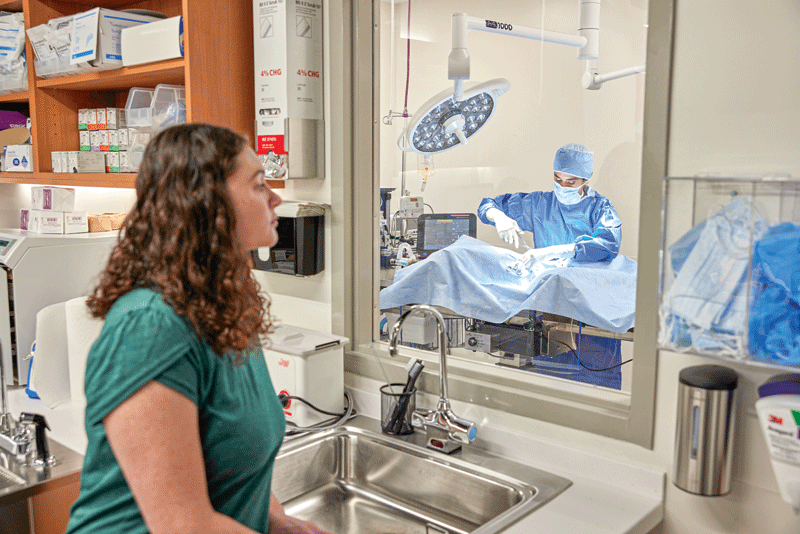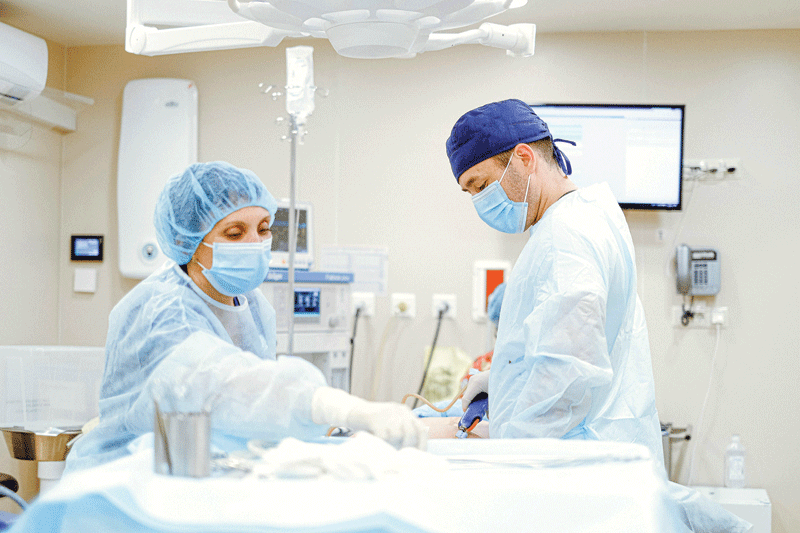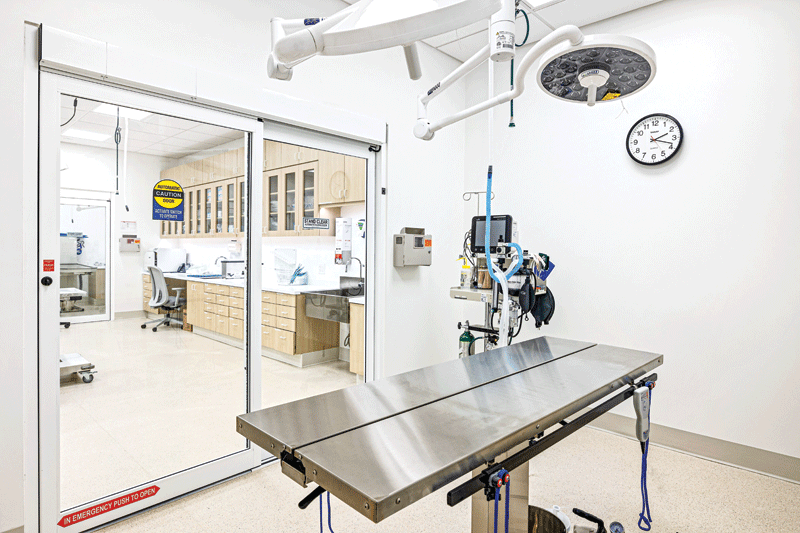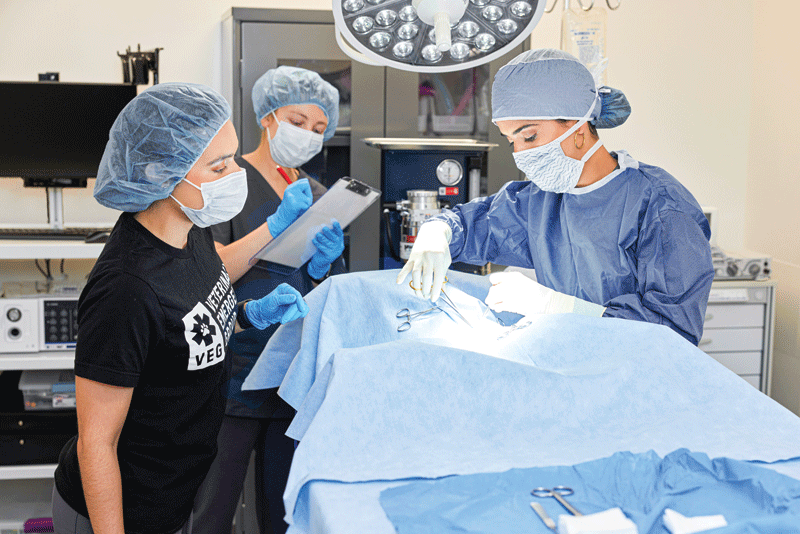
Veterinary operating rooms (ORs) are seeing a transformation driven by a mixture of technological innovation, animal welfare, and ergonomic considerations. As veterinary medicine advances, the design trends in these specialized spaces are evolving to meet the demands of modern practices, optimizing workflow and prioritizing the well-being of both patients and veterinary teams.
“Today’s veterinary operating rooms reflect trends in human healthcare,” says Bronwyn Fullagar, BVSc, MS, DACVS-SA, director of surgical education at White Plains, N.Y.-based Veterinary Emergency Group (VEG). “Many specialty centers now have hybrid operating rooms, which are large, sophisticated spaces combining conventional surgical suites with advanced medical imaging (fluoroscopy, CT, and fluorescence imaging). This allows intra-operative imaging to be performed and facilitates minimally invasive approaches.”
There has also been an increased emphasis on flexibility and a rise in modular designs, which allow for customization based on the specific needs of a practice, and versatile layouts; these can adapt to different types of surgeries and procedures.
Gabrielle Fadl, DVM, senior director of medical projects and programs at Brooklyn, N.Y.-based Bond Vet, shares some of the latest trends in operating room design she has seen: tech-focused in incorporating advanced surgical equipment, such as minimally invasive surgical tools (surgical lasers), integration of telemedicine, patient comfort and safety upgrades with non-slip surfaces and heated tables, and incorporating natural light where possible for improved work environment and visibility.

“Today’s set-ups are designed with layouts that optimize functionality through strategically placing programs to ensure equipment is positioned for easy access and minimize effort in moving from space to space,” Dr. Fadl says. “They are also designed to be safe for both the teams and pets by using easy-to-clean durable seamless surfaces and installing high-quality HVAC systems that ensure proper ventilation and airflow.”
Taylor Harper, vice president of development for Small Door Veterinary, who heads and manages the in-house design team for the New York-based company, has seen one trend gaining steam the past few years throughout the office.
“Wellness or medical programmed spaces are being designed to be more inviting and comfortable,” Harper says. “Traditionally, these spaces have been designed and built for function over form. In the veterinary field in particular, that has left us with very cold and sterile looking spaces. There has been a shift/awakening for some in that sterile spaces don’t need to feel so cold and uninviting. There is a wide world of materials out there that can be thoughtfully assembled to be both sterile and evoke warmth to relieve anxiety for employees, pets, and pet owners.”

Devising a design plan
The frequency of room renovations and updates with newer technology and design schemes in veterinary clinics can vary depending on several factors. These include changing compliance that requires upgrades to stand in line with regulatory requirements, practice growth to meet the demands of serving the pets, aesthetics to elevate the experience for clients, and competitive advantage in your market to diversify your offering from others.
VetSurg, a Ventura, Calif.-based veterinary surgical hospital, recently completed and moved into four new operating rooms.
“We spent lots of time in the research and design phase and travelled to look at other setups and gleam ideas from the other facilities’ experiences,” says Ian G. Holsworth, BSc, BVSc, MANZCVS, a small animal surgeon with VetSurg, who added it took two-and-a-half years to complete. “Frustration over time clarifies thoughts … and form follows function.”
To create the ideal operating rooms, the VetSurg team considered the safety of patient under anesthesia, the ability to perform the designated procedure in a complete, efficient, and ergonomically favorable position, and factored in the equipment needed, its ideal location in an OR, and its ease of access and adjustment for the operative and non-operative staff depending on the equipment being used.
“Once those three factors are considered, then the follow-on considerations are how large do we need the OR(s) to be, what equipment will need to be present, where will it be housed within the OR, what digital pathway with signals to and from equipment will need to be established, what the overall operative flow are we are trying to achieve, and how can we enhance and simplify that flow?” Holsworth says.
The physical locations of the patient, operative (surgeon and surgical assistant) and non-operative staff (anesthetist, circulating nurse/technician) and how their physical selves will move within the room will dictate layout of the room along with the equipment used and needed to be accessed by the different staff members present.
“The concept is to build a room where the limitations to surgical success do not include the physical set-up and equipment present, but rather the severity of the surgical challenge and the competency of the team that is addressing them,” Holsworth says. “After 30 years of surgery, my expertise and that of my long-standing team members was utilized to maximize our design and layout and minimize the things that frustrated and foiled us in the past.”
Harper notes ergonomic considerations are another key focus in veterinary OR design.
“Thoughtful placement of equipment and supplies, along with adjustable lighting and work surfaces, enable veterinary teams to perform surgeries efficiently and comfortably,” he says. “These considerations not only improve the workflow but also reduce the risk of injury and fatigue among veterinary professionals.”
Mark Fealey, DVM, an ER doctor at VEG, says open-concept ORs are in vogue, as they allow owners to see just how much goes into not just surgery, but the prep work and post-op recovery through a large, designated window.
“Advantages of an open-concept ER are that it’s very quick to address owners, allows owners to be a part of the experience, builds trust between veterinarian and customer, allows anxious patients to feel some relief knowing owner is present, gives customers a possible glimpse of what veterinary staff undergo on a daily basis and owners can act as another set of eyes and ears,” Dr. Fealey says. “I think that transparency adds value to the owners’ perspective and trust between medical team and owners.”

A finished project
Christie Long, DVM, chief medical officer at Culver City, Calif.-based Modern Animal, says all the company’s clinics have ORs equipped with the latest technology and medical-grade materials with recycled content, with future recycling potential chosen wherever possible.
“We also installed new high-efficiency HVAC units with integrated filters and a high volume of air exchange to improve indoor air quality, while skylights throughout the space minimize the need for artificial lighting and maximize daylight to support human and animal circadian rhythms,” Dr. Long says. “Modern Animal has prioritized design as a means to create a more healing environment for pets and their owners, as well as space where vets and staff want to work.”
All four VetSurg ORs are approximately 18 ft. x 18 ft. and contain hanging booms for lights, monitors and an equipment boom which carries data, power, oxygen, nitrogen, waste gas, and fluid suction. The surgery “box” is contained, isolated, and has hard ceilings at 12 ft.
“The room interiors feature specialized medical use vinyl flooring, floor inset color-coded surgery table floor patch to delineate traffic flow, people position, and the general use areas of each room,” Holsworth says. “There is pass-through cabinetry in each room to hold surgical packs and surgical disposables. These are glass covered from waist height up and have bi-motion drawers below to service both rooms and allow visual access to neighboring rooms. There’s also multiple large 8 ft. x 4 ft. windows looking in to each OR to minimize visualize ‘boxing’ and allow visual expansion beyond the room confines.”
Surgical visualization is enhanced and provided by large multi-arm, multi-joint mobile ceiling surgical booms, with two to three in each room to harbor surgical lights; as well as boom surgical monitors for visual access for intra-operative visualization of varies modalities (i.e. from arthroscopy to laparoscopy, thoracoscopy, fluoroscopy, and radiography).
“The unique hanging equipment boom provides anesthesia in-and-out gas supply and collection, suction, data, electricity, nitrogen gas supply for gas-driven power equipment,” Holsworth says. “We also have wall-mounted 55-in medical grade monitors in all ORs for medical and surgical flow software display. The combination of all these features creates a truly state-of-the-art surgical environment where patient safety, patient surgical care, surgical team efficiency and comfort are maximized.”
Overall, the evolution of veterinary OR design is creating safer, more efficient, and technologically advanced spaces benefitting both animals and veterinary teams. These trends signal a promising future for veterinary medicine, where cutting-edge facilities support the best possible care for animal companions.
A graduate of the University of Miami, Keith Loria is a D.C.-based, award-winning journalist who has been writing for major publications for close to 20 years on topics as diverse as veterinary medicine, travel, and entertainment. Loria started his career with the Associated Press and has held high editorial positions at publications aimed at healthcare, sports, and technology.
